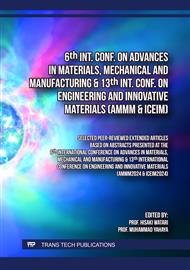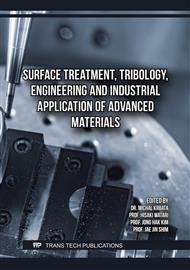[1]
Z. Liu, Z. Wang, C. Gao, X. Liu, R. Liu, Z. Xiao, J. Sanderson, Enhanced rolling contact fatigue behavior of selective electron beam melted Ti6Al4V using the ultrasonic surface rolling process, Materials Science and Engineering A. 833 (2022) 142352.
DOI: 10.1016/j.msea.2021.142352
Google Scholar
[2]
S.A. Ojo, B. Bowser, K. Manigandan, G.N. Morscher, Y. Dong, A.L. Gyekenyesi, O.E. Scott-Emuakpor, Improving fatigue life of additively repaired Ti-6Al-4V subjected to laser-assisted ultrasonic nanocrystal surface modification, International Journal of Fatigue. 173 (2023) 107663.
DOI: 10.1016/j.ijfatigue.2023.107663
Google Scholar
[3]
X. Luo, Y. Wang, N. Dang, K. Tian, K. Wang, C. Zhao, X. Zha, X. Wang, Y. Yu, Gradient microstructure and foreign-object-damaged fatigue properties of Ti6Al4V titanium alloy processed by the laser shock peening and subsequent shot peening, Materials Science and Engineering: A. 849 (2022) 143398.
DOI: 10.1016/j.msea.2022.143398
Google Scholar
[4]
N. Maharjan, T. Ramesh, Z. Wang, High energy laser shock peening of Ti6Al4V alloy without any protective coating, Applied Surface Science. 638 (2023) 158110.
DOI: 10.1016/j.apsusc.2023.158110
Google Scholar
[5]
M. Thomas, M. Jackson, The role of temperature and alloy chemistry on subsurface deformation mechanisms during shot peening of titanium alloys, Scripta Materialia. 66 (2012) 1065–1068.
DOI: 10.1016/j.scriptamat.2012.02.049
Google Scholar
[6]
C. Ye, S. Suslov, B.J. Kim, E.A. Stach, G.J. Cheng, Fatigue performance improvement in AISI 4140 steel by dynamic strain aging and dynamic precipitation during warm laser shock peening, Acta Materialia. 59 (2011) 1014–1025. https://doi.org/10.1016/j.actamat. 2010.10.032.
DOI: 10.1016/j.actamat.2010.10.032
Google Scholar
[7]
W. Zhao, D. Liu, H. Zhang, J. Liu, C. Ma, R. Zhang, T. Huang, Y. Dong, C. Ye, H. Ding, Improving peening efficacy through high-amplitude short duration pulsed current, Journal of Alloys and Compounds. 926 (2022) 166987.
DOI: 10.1016/j.jallcom.2022.166987
Google Scholar
[8]
H. Li, L.F. Peng, B. Meng, Z.T. Xu, L.L. Wang, G. Ngaile, M.W. Fu, Energy field assisted metal forming: Current status, challenges and prospects, International Journal of Machine Tools and Manufacture. 192 (2023).
DOI: 10.1016/j.ijmachtools.2023.104075
Google Scholar
[9]
J. Liu, S. Suslov, Z. Ren, Y. Dong, C. Ye, Microstructure evolution in Ti64 subjected to laser-assisted ultrasonic nanocrystal surface modification, International Journal of Machine Tools and Manufacture. 136 (2019) 19–33. https://doi.org/.
DOI: 10.1016/j.ijmachtools.2018.09.005
Google Scholar
[10]
S.A. Ojo, B. Bowser, K. Manigandan, G.N. Morscher, Y. Dong, A.L. Gyekenyesi, O.E. Scott-Emuakpor, Improving fatigue life of additively repaired Ti-6Al-4V subjected to laser-assisted ultrasonic nanocrystal surface modification, International Journal of Fatigue. 173 (2023) 107663.
DOI: 10.1016/j.ijfatigue.2023.107663
Google Scholar
[11]
V.Y. Kravchenko, Influence of the Magnetic Field on Electronic Deceleration of Dislocations, ZhETF Pisma Redaktsiiu. 12 (1970) 551.
Google Scholar
[12]
V.Y. Kravchenko, Effect of directed electron beam on moving dislocations, Soviet Physics JETP. 24 (1967) 1135–1142.
Google Scholar
[13]
M.I. Molotskii, Theoretical basis for electro- and magnetoplasticity, Materials Science and Engineering A. 287 (2000) 248–258. https://doi.org/.
DOI: 10.1016/s0921-5093(00)00782-6
Google Scholar
[14]
V.I. Alshits, E. V. Darinskaya, O.L. Kazakova, E.Y. Mikhina, E.A. Petrzhik, Magnetoplastic effect in non-magnetic crystals and internal friction, Journal of Alloys and Compounds. 211/212 (1994) 548–553.
DOI: 10.1016/0925-8388(94)90563-0
Google Scholar
[15]
W.S. Yip, S. To, Sustainable manufacturing of ultra-precision machining of titanium alloys using a magnetic field and its sustainability assessment, Sustainable Materials and Technologies. 16 (2018) 38–46.
DOI: 10.1016/j.susmat.2018.04.002
Google Scholar
[16]
A.K. Khalil, W.S. Yip, S. To, Theoretical and experimental investigations of magnetic field assisted ultra-precision machining of titanium alloys, Journal of Materials Processing Technology. 300 (2022).
DOI: 10.1016/j.jmatprotec.2021.117429
Google Scholar
[17]
W.S. Yip, S. To, Reduction of material swelling and recovery of titanium alloys in diamond cutting by magnetic field assistance, Journal of Alloys and Compounds. 722 (2017) 525–531.
DOI: 10.1016/j.jallcom.2017.06.167
Google Scholar
[18]
S. Hatefi, K. Abou-El-Hossein, Experimental investigation on the effects of magnetic field assistance on the quality of surface finish for sustainable manufacturing of ultra-precision single-point diamond turning of titanium alloys, Frontiers in Mechanical Engineering. 8 (2022) 1–14.
DOI: 10.3389/fmech.2022.1037372
Google Scholar
[19]
J.F. Xiao, F. Guo, C. Zhang, X. Chen, J.G. Zhang, J.F. Xu, Experimental investigation for ultra-precision cutting of nickel based superalloy with the assistance of magnetic field, Science China Technological Sciences. 65 (2022) 2170–2177.
DOI: 10.1007/s11431-022-2150-4
Google Scholar
[20]
M.C. Jo, J. Yoo, A. Amanov, T. Song, S.H. Kim, S.S. Sohn, S. Lee, Ultrasonic nanocrystal surface modification for strength improvement and suppression of hydrogen permeation in multi-layered steel, Journal of Alloys and Compounds. 885 (2021) 160975.
DOI: 10.1016/j.jallcom.2021.160975
Google Scholar
[21]
J. Liu, S. Suslov, A. Vellore, Z. Ren, A. Amanov, Y.S. Pyun, A. Martini, Y. Dong, C. Ye, Surface nanocrystallization by ultrasonic nano-crystal surface modification and its effect on gas nitriding of Ti6Al4V alloy, Materials Science and Engineering A. 736 (2018) 335–343.
DOI: 10.1016/j.msea.2018.08.089
Google Scholar
[22]
Y.I. Golovin, Magnetoplastic effects in solids, Physics of the Solid State. 46 (2004) 789–824. https://doi.org/.
DOI: 10.1134/1.1744954
Google Scholar
[23]
Q. Xu, K. Li, Z. Cai, Y. Wu, Effect of Pulsed Magnetic Field on the Microstructure of TC4 Titanium Alloy and Its Mechanism, Jinshu Xuebao/Acta Metallurgica Sinica. 55 (2019) 489–495. https://doi.org/.
Google Scholar



